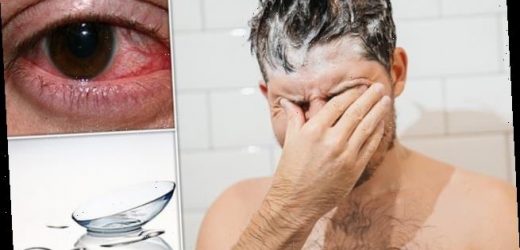Wearing contact lenses in the shower can increase your risk of developing a painful sight-threatening infection up to SEVEN-fold, study warns
- The habits of 78 contact lens wearers were analysed by researchers from the UK
- Of these, 37 had previously developed contact lens-related microbial keratitis
- The risk of infection increased with the frequency of showering, the team found
- Those who slept with their lenses also increased their risk around three-fold
Regularly leaving your contact lenses in while taking a shower can increase your risk developing a painful and eyesight-threating infection seven-fold, a study warned.
Researchers from the UK surveyed the habits of 78 contact lens wearers to determine the risk factors for developing contact lens-related microbial keratitis.
This condition causes a painful redness of the eye and ulcers on the surface of the cornea. If left untreated, it can cause blurred vision and permanent corneal scarring.
The team also found that wearing contact lenses while sleeping can increase your risk of microbial keratitis three-fold.
It is estimated that some 4 million people in the UK wear contact lenses. Associated eye infections are common, and a leading cause of single-eye vision loss.
Microbial keratitis affects thousands of people in the UK alone each year.
Keeping your contact lenses in while taking a shower (pictured) can increase your risk developing a painful and eyesight-threating infection seven-fold, a study warned (stock image)
‘Contact lenses for visual correction offer many benefits,’ ophthalmologist Parwez Hossain of the University of Southampton told the Telegraph.
However, he added, ‘contact lens-related microbial keratitis is a frequent cause of permanent visual impairment and some cases may even need a corneal transplant or lead to loss of the eye.’
‘Poor contact lens hygiene is a known contributor to infection, with 66 per cent of complications attributed to poor hygiene practices and great variation in hygiene awareness and recognition of the risks among regular contact lens wearers.’
In their study, Professor Hossain and colleagues interviewed 78 lens wearers— of whom 37 had previously developed microbial keratitis — about their use of contacts.
Specifically, the subjects were asked about the type of lenses they used, how long they wore them for, their personal hygiene habits and whether or not they ever slept or showered while still wearing their lenses.
The team found that not removing lenses before showering was a major cause of infection, with the risk of microbial keratitis increasing seven-fold among those who took a shower daily.
Shower heads can provide a breeding ground for bacteria which can ultimately end up spread under the surface of a contact lens.
Similarly, the subjects who slept in their lenses — depriving the cornea of oxygen and recovery time — were found to increase their risk of infection three-fold.
Age was also found to be a risk factor — with those between the ages of 25–39 being at the greatest risk.
Microbial keratitis causes a painful redness of the eye (pictured) and ulcers on the surface of the cornea. If left untreated, it can cause blurred vision, corneal scarring and blindness
‘Contact lens wear is safe providing wearers carefully follow personal hygiene advice issued by their optometrist or contact lens practitioner,’ said paper author Parwez Hossain
‘Worldwide approximately 140 million people successfully wear contact lenses with a very low incidence of any serious complications,’ president-elect of the British Contact Lens Association, Neil Retallic, told the Telegraph.
However, he added, ‘this research is welcomed to help promote and raise awareness of how to maximise safe wear.’
‘We have supporting guidance available for both eye care teams and contact lens wearers to influence attitudes and to reinforce good contact lens routines.’
‘We must all work together to ensure behaviours which minimise risk become permanent habits.’
‘Contact lens wear is safe providing wearers carefully follow personal hygiene advice issued by their optometrist or contact lens practitioner,’ added Professor Hossain.
The full findings of the study were published in the journal BMJ Open Ophthalmology.
ABOUT MICROBIAL KERATITIS
What is microbial keratitis?
Microbial keratitis is an infection on the cornea — the clear window on the front of the eye.
It is often related to contact lens wear or, less commonly, due to a scratch on the surface of the eye or a pre-existing eye condition.
Infection is more likely with incorrect contact lens cleaning or storage, incorrect use of disposable lenses or wearing lenses overnight.
Microbial keratitis can be a serious condition if not treated and can sometimes affect your vision and may leave a scar, even with the correct treatment.
What are the symptoms of microbial keratitis?
Microbial keratitis causes a painful red eye and sometimes blurred vision.
At first, it feels as though there is something in your eye.
Your eye becomes increasingly painful due to the development of an ulcer on the surface of the cornea.
Sometimes, you can see this ulcer, which looks like a small white spot on the cornea over the coloured part of your eye.
What is the treatment?
Antibiotic drops are usually used. You are likely to need to put the drops in very frequently in the first instance.
This can be up to every hour and sometimes you will need to continue through the night if the infection is severe.
The frequency of the drops is then reduced once the ulcer is seen to be reducing in size.
Sometimes, your antibiotics may be changed if there is no sign of improvement after several days, or if the corneal sample results show another drop would be more appropriate.
It is very important that you put your drops in regularly as these types of infections can get much worse if not treated properly.
You should not wear contact lenses while the infection is present and for a few weeks after the infection clears, as this can lead to a serious deterioration in your condition.
After the infection is fully recovered, please return to your contact lens practitioner to check your contact lens fit for use.
SOURCE: NHS
Source: Read Full Article




